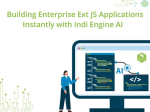Difference Between Framework Vs Library
The difference between library and framework is often confused terms for many. We often use these terms to refer to the same things. Both libraries and software frameworks are just a collection of reusable code written by others. Their goal is to make ordinary problems easier to address. But there is a distinction between them. To show the distinction between these concepts, we can use a cottage as a metaphor. A library is similar to building a cottage from the ground up. You may design your house as you want, with just about any architecture you want, and you can arrange your rooms however you want. Framework, on the other hand, is like buying a new cottage. You don’t have to deal with construction issues, but you can’t pick how to arrange your areas because the cottage is already completed. In this article, we will be discussing the difference between a framework and a library.
What Is A Framework?
The key difference between a framework and a library is that a framework’s code does not contain “completed” functions. Frameworks provide the foundation and basic architecture for building software applications. When using a framework, the control flow is managed by the framework itself, which calls the developer’s code at certain points. This is known as the “inversion of control” principle.
A framework gives you structure—it tells you where to write your code and often enforces best practices and design patterns. This is what differentiates it from using a simple library, where the developer controls the flow and just calls predefined functions.
In the framework vs programming language vs library comparison, the framework operates one level above the programming language, providing architectural scaffolding using that language, while libraries are collections of smaller utilities or functions written in the language.
Components of a Framework
When examining the UI components of a framework like Sencha Ext JS, it’s crucial to understand its key elements:
- Pre-built UI Components: Buttons, grids, forms, and charts to streamline UI creation.
- Layout Managers: Help organize components within the user interface.
- Event Handling: Manage user interactions effectively.
- Data Models & Stores: Manage client-side data and communicate with backend APIs.
- Theming & Styling: Customize the look and feel of your app.
- Modules: Routing, validation, internationalization, and more.
Frameworks also define a clear project structure and support automation through tools like build systems and command-line interfaces.
In modern development, this ties into topics like web framework vs library, where frameworks like Angular or Vue provide an entire toolchain, whereas libraries like React are only concerned with one layer (e.g., view rendering).
Why Do We Use Frameworks?
Frameworks simplify the software development process by:
- Reducing repetitive coding
- Enabling code reuse
- Improving scalability and maintainability
- Offering security and performance enhancements
- Simplifying testing and debugging
- Enforcing consistent project structure
A framework provides cohesion, especially for larger applications. In large teams, having a framework ensures all developers follow the same patterns and conventions.
Frameworks are especially powerful in enterprise contexts, which is why developers compare options like enterprise library vs entity framework when considering scalable architecture patterns.
How Frameworks Help Organize Your Code
Frameworks help you organize your code. They give you a structure to follow, so you don’t have to figure out everything from scratch. Think of them like a guide that sets the rules for your project. Frameworks make it easier to build large applications because they lay down a clear plan for where things should go.
They also encourage best practices. Many frameworks come with built-in tools for things like testing, debugging, and routing. This means you won’t have to write repetitive code. You can focus on the unique parts of your app instead.
If you’re working on a big project, frameworks keep things neat. They help make your code more organized, reusable, and easy to scale. The framework itself controls the flow of the app, which means fewer mistakes. It’s like having a solid foundation for building your app. In the end, frameworks make your life easier when it comes to building reliable and scalable applications.
Why Choose a Library for Specific Tasks?
Libraries are perfect when you need a simple solution for a specific task. Unlike frameworks, libraries give you more freedom. You pick what you need, and you use it in your project. It’s like adding a tool to your toolbox, not overhauling the whole project.
For example, if you just need to manipulate arrays or build user interfaces, you can use a library like Lodash or React. You don’t have to follow a strict structure. Libraries let you control how your app works, without forcing you into any particular setup.
Libraries are also lighter than frameworks. They load faster and are easier to integrate into your existing code. This is great if you want to keep things simple. You don’t need to rewrite your entire app—just add the library to improve certain features. Libraries are all about making your app better without adding extra complexity.
Framework vs Other Development Tools
Framework vs Platform vs Library
A platform is the underlying environment (like Java Virtual Machine or Android OS), a framework provides a development structure, and a library offers reusable functionality. Knowing when to use each is crucial for efficient architecture.
Framework vs Programming Language vs Library
Programming languages are the base (e.g., JavaScript, Python), frameworks are built on top to offer structure (e.g., Angular, Django), and libraries (e.g., Lodash, NumPy) offer small, targeted solutions.
Static Library vs Framework iOS / Xcode Framework vs Static Library
In iOS development, a static library is embedded directly into the app binary, while a framework (dynamic or static) is a bundle containing code and resources. Xcode frameworks provide better modularity and can be reused across multiple apps more easily.
Software Library vs Framework
In the debate between software library vs framework, the key distinction lies in control flow and the level of abstraction.
- Software Library: A library is a collection of pre-written code that developers use to perform specific tasks. The developer calls the library functions as needed. It’s essentially a set of tools for developers to utilize in their projects, which gives them full control over the application’s flow. Libraries are often modular and easy to integrate into an existing project.
- Framework: A framework, in contrast, defines the structure and flow of the application. It provides a foundation upon which developers build their applications but controls the application flow. With a framework, developers plug their own code into predefined slots and are bound by the framework’s conventions and design patterns.
This distinction between a software library vs framework is particularly evident when looking at comparisons such as static library vs framework iOS. In iOS development, static libraries are collections of functions that you can integrate into your app, while frameworks, being more comprehensive, provide a set of tools and services (such as APIs) to structure your app, including resources and code.
Examples Of Frameworks
Ext JS
Sencha Ext JS is a robust JavaScript framework for building data-intensive, cross-platform web applications. It offers a complete solution with over 140 pre-built UI components, layout managers, and robust data handling tools. Ext JS also supports theming and accessibility out of the box. With tools like Sencha CMD and Sencha Inspector, developers can build, optimize, and debug large-scale applications efficiently. As a JavaScript framework, it enables a faster go-to-market and is ideal for enterprise-grade applications.
Angular
Angular is a powerful front-end framework developed by Google for building client-side web applications, particularly single-page applications (SPAs). It includes a component-based architecture, dependency injection, routing, and built-in form validation.
In discussions of angular framework vs react library, Angular is recognized for being more opinionated and complete out of the box, while React is leaner and more flexible but requires more integration with external libraries.
Django
Django is a full-stack Python web framework that follows the Model-View-Template (MVT) architecture. It emphasizes reusability, rapid development, and the DRY (Don’t Repeat Yourself) principle. It comes with an admin interface, ORM, authentication system, and more.
When evaluating python framework vs library, Django exemplifies a framework because it controls the app flow, while a library like Requests or Pandas provides specific tools.
Express
Express is a lightweight Node.js web application framework. It simplifies handling HTTP requests, middleware, and routing. Express is often the base for building REST APIs and is known for its flexibility.
It’s commonly used with libraries like Mongoose (for MongoDB) or templating engines like EJS. In the api vs framework vs library landscape, Express acts as a framework to manage HTTP layers, while libraries offer tools for specific tasks.
Rails
Ruby on Rails is a convention-over-configuration framework that simplifies web development in Ruby. It’s favored by startups and enterprises alike due to its productivity, clean syntax, and strong developer ecosystem.
Rails has a large number of reusable libraries, or “gems,” which reduce development time and complexity.
Spring
Spring is a comprehensive Java framework that provides infrastructure support for developing Java applications. It includes modules for dependency injection, transaction management, security, and more.
It’s commonly used in enterprise applications and forms the foundation for the Spring Boot framework, which simplifies microservices development.
In the framework vs library Java debate, Spring clearly defines itself as a full-fledged framework offering a structured way to build and deploy applications.
What Is A Library?
A software library is a collection of reusable functions, classes, or routines written to perform specific tasks. Unlike frameworks, libraries don’t control the flow of execution in your program—you do.
In the api vs library vs framework comparison, APIs are contracts for communication, libraries implement those APIs, and frameworks orchestrate the structure around them.
Why Do We Need A Library?
Libraries save time by offering pre-written solutions to common programming tasks, such as data formatting, date handling, or HTTP requests. They make applications more modular, reusable, and maintainable.
In the debate between framework vs library Java, using Java libraries like Apache Commons or Jackson allows developers to quickly integrate features into existing codebases without having to use full frameworks like Spring.
Examples Of Libraries
React
React is a JavaScript library for building user interfaces, particularly for single-page applications. Created by Facebook, it introduced the concept of components and a virtual DOM for optimized rendering.
In the ongoing angular framework vs react library discussion, React is not a full framework. It’s only responsible for rendering views, requiring external libraries for routing or state management.
Redux
Redux is a JavaScript library for managing application state. It is most commonly used with React but can be integrated with other frameworks or libraries like Angular.
Three.js
Three.js is a JavaScript library for rendering 3D graphics using WebGL. It abstracts complex math and WebGL code, making it easier for developers to build immersive 3D experiences in the browser.
Lodash
Lodash is a utility library that simplifies JavaScript programming. It includes functions for data manipulation, array operations, and more—essential for improving code readability and maintainability.
jQuery
jQuery is a fast, small, and feature-rich JavaScript library. It simplifies DOM manipulation, event handling, animation, and AJAX. Though its usage has declined with modern frameworks, it remains a critical part of web development history.
In debates like jquery framework vs library, it’s important to note that jQuery is a library, not a framework, because it does not define or control application architecture.
What Are The Technical Differences Between Library vs. Framework?
The main technical difference is inversion of control:
- With a library, you call the code (you’re in control).
- With a framework, the framework calls your code (it’s in control).
| Feature | Library | Framework |
|---|---|---|
| Control Flow | Developer controls the flow | Framework controls the flow (Inversion of control) |
| Replaceability | Easily replaceable | Difficult to replace |
| Integration | Easy to integrate in existing apps | Requires full structure |
| Size and Complexity | Smaller, faster | Larger, may increase load time |
| Structure Enforced | No | Yes |
Advantages of Frameworks Over Libraries
- Enforced best practices and conventions
- Predefined structure improves maintainability
- Scales better for large applications
- Offers complete toolsets for testing, debugging, routing, and more
- Integrated ecosystem and third-party support
This is why many developers opt for programming frameworks vs libraries when building enterprise applications.
FAQs
What is a library in programming?
A library in programming is a reusable collection of code that provides specific functionalities, such as data handling or calculations.
What is a software library?
A software library is a bundle of pre-written code that developers can use to optimize their development workflow.
What are libraries in coding?
Libraries in coding are collections of code modules created to perform common programming tasks and reduce redundancy.
What is a code framework?
A code framework is a structured set of tools and conventions that dictate how software applications should be developed and organized.
What is a program library?
A program library contains precompiled routines that programs can use to perform specific tasks, such as connecting to databases or rendering graphics.
What are programming libraries?
Programming libraries are sets of code that offer specific features or functions to simplify development in programming languages.
What is a library in computer programming?
In computer programming, a library is a set of pre-written code that can be included and used in your application to add specific features.
Conclusion
Both the framework vs library are essential tools in Custom software development. Libraries offer focused functionality while frameworks provide an architectural foundation for building entire applications. The difference between library and framework, or static library vs framework iOS, understanding the roles of each helps in choosing the right tool for the job.
Get clarity with real examples—and start your Ext JS free trial today.

Pavel Perminov, the solo founder and developer of Indi Engine AI, for an insightful session…

Data-rich applications often present users with powerful but complex data grids. While traditional filtering and…

Modern web users expect pixel-perfect interfaces and enterprise-grade performance—delivered yesterday. Yet most teams still spend…










